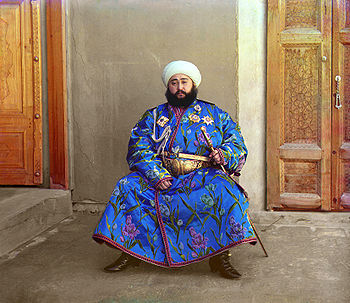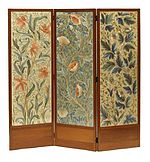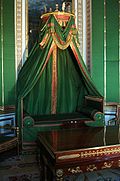- Portal:Textile arts
-
- Wikipedia portals:
- Culture
- Geography
- Health
- History
- Mathematics
- Natural sciences
- People
- Philosophy
- Religion
- Society
- Technology
The Textile arts Portal
The textile arts are those arts and crafts that use plant, animal, or synthetic fibers to construct practical or decorative objects. Textiles cover the human body to protect it from the elements and to send social cues to other people. Textiles are used to store, secure, and protect possessions, and to soften, insulate, and decorate living spaces and surfaces.The word textile is from Latin texere which means "to weave", "to braid" or "to construct". The simplest textile art is felting, in which animal fibers are matted together using heat and moisture. Most textile arts begin with twisting or spinning and plying fibers to make yarn (called thread when it is very fine and rope when it is very heavy). Yarn can then be knotted, looped, braided, or woven to make flexible fabric or cloth, and cloth can be used to make clothing and soft furnishings. All of these items – felt, yarn, fabric, and finished objects – are referred to as textiles.
Textiles have been a fundamental part of human life since the beginning of civilization. The history of textile arts is also the history of international trade. Tyrian purple dye was an important trade good in the ancient Mediterranean. The Silk Road brought Chinese silk to India, Africa, and Europe. Tastes for imported luxury fabrics led to sumptuary laws during the Middle Ages and Renaissance. The industrial revolution was a revolution of textiles technology: cotton gin, the spinning jenny, and the power loom mechanized production and led to the Luddite rebellion.
More about Textile arts... Selected picture
Alim Khan wearing ceremonial robes in an early color photograph by Sergey Prokudin-Gorsky shot in 1911. Lavish silk and embroidery is symbolic of rank in many cultures.
Selected biography
John Henry Dearle or J. H. Dearle (1860–1932) was a British textile and stained glass designer trained by Pre-Raphaelite artist and craftsman William Morris. Dearle designed many of the later wallpapers and textiles released by Morris & Co., and contributed background and foliage patterns to tapestry designs featuring figures by Edward Burne-Jones and others. Beginning in his teens as a shop assistant and then design apprentice, Dearle rose to become Morris & Co.'s chief designer by 1890, creating designs for tapestries, embroidery, wallpapers, woven and printed textiles, stained glass, and carpets. Following Morris's death in 1896, Dearle was appointed Art Director of the firm, and became its principal stained glass designer on the death of Burne-Jones in 1898.Did you know...
- ...that canvaswork designs of plants called slips appliquéd on silk or velvet (pictured) were often based on woodcuts from herbals?
- ...that Navajo rugs sold for $50 in gold as early as 1850?
- ...that Emil Rieve was elected president of his local union when he was only 22 years old, and president of the Textile Workers Union of America when he was 46?
Selected article
A baldachin, or baldaquin (Italian: baldacchino or baldachino), is a canopy of state over an altar or throne, It had its beginnings as a cloth canopy, but in other cases it is a sturdy, permanent architectural feature, particularly over high altars in cathedrals. A cloth of honour is a simpler cloth hanging vertically behind the throne, which may be combined with a canopy. In the Middle Ages, a hieratic canopy of state or cloth of state was hung over the seat of a personage of sufficient standing, as a symbol of authority. The seat under such a canopy of state would normally be raised on a dais. Emperors and kings, reigning dukes and bishops were accorded this honour. In a 15th-century manuscript illumination the sovereign Grand Master of the Knights Hospitaller in Rhodes sits in state to receive a presentation copy of the author's book. His seat is raised on a carpet-covered dais and backed with a richly embroidered dosser (French, "dos"). Under his feet is a cushion, such as protected the feet of the King of France when he presided at a lit de justice. The King of France was also covered by a mobile canopy during his coronation, held up on poles by several peers of France.Categories
WikiProjects
- Parent project
Wikipedia:WikiProject Arts

- Main project
Textile Arts WikiProject
- Participants
- Related projects
WikiProject Fashion • WikiProject Knots • WikiProject Sculpture • WikiProject Visual arts
What are WikiProjects?
Selected quote
Quality content
Main topics
Textile arts Fundamentals: • Crochet • Embroidery • Knitting • Lace • Needlework • Sewing • Spinning • Textile • Weaving • Yarn
Additional topics: Beadwork • Carpet • Clothing • Dyeing • Felt • Fiber • History of clothing and textiles • Linen • Macramé • Patchwork • Quilting • Rug making • Sewing needle • Tapestry • Timeline of clothing and textiles technology • Traditional rug hooking • Wool
Things you can do
- Place the {{WikiProject Textile Arts}} project banner on the talk pages of all articles within the scope of the project.
- Place the {{Portal|Textile arts}} portal template in the See also section of associated articles.
- Improve a top priority textile arts article.
- Assessment: Rate unassessed articles for quality and importance.
- Cleanup: Tassel, Burlap, More articles for cleanup...
- Expand: History of textiles and clothing, Casting on (knitting)
- Original research removal: Clothing, History of knitting
- Requested articles: Japanese embroidery, Argentella, Battenberg (lace)
- Requested pictures: Hairpin lace, Point de Gaze, Buratto, Youghal lace, Hollie Point
- Verify: Clothing, Bobbinet, Braid, Canvas, Cardigan (sweater), Cotton-spinning machinery, Crocheted lace, Damask, Distaff, Dobby loom, Drawn thread work, Dyeing, Hemline, Ikat, Lace, Natural fiber, Neckline, Oilskin, Overlock, Machine embroidery
- Stubs: Afghan blanket, Emilie Bach, Candlewicking, Dip stitch (knitting), Elongated stitch (knitting), More stubs...
Related portals
Associated Wikimedia
Categories:- Textile arts
- Textile arts portal
- Arts portals
Wikimedia Foundation. 2010.









